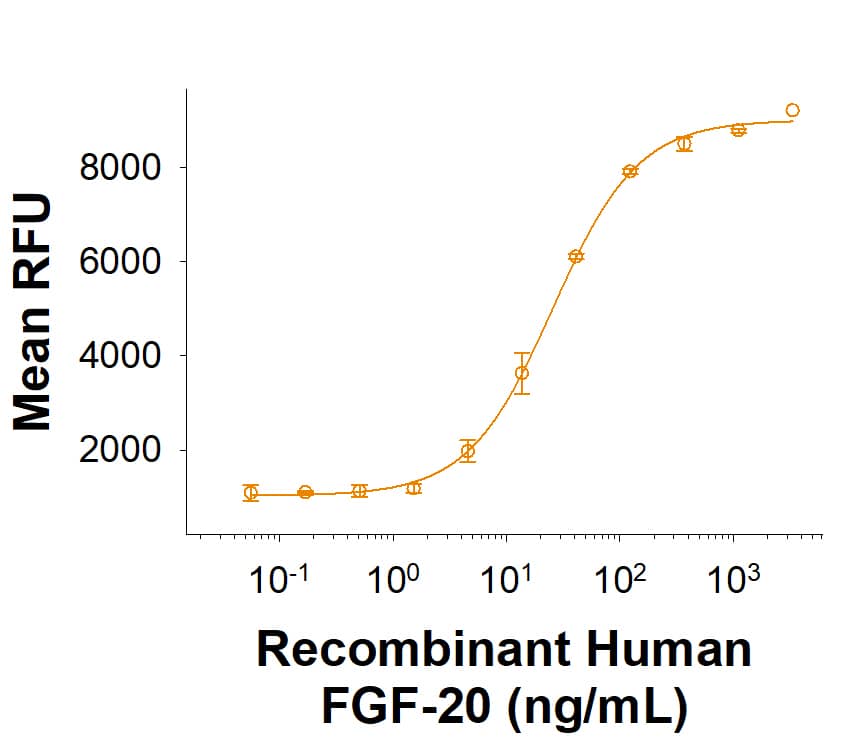Recombinant Human FGF-20 Protein
R&D Systems, part of Bio-Techne | Catalog # 2547-FG

Key Product Details
Product Specifications
Source
Ala2-Thr211, with an N-terminal Met and a 6-His tag
Purity
Endotoxin Level
N-terminal Sequence Analysis
Predicted Molecular Mass
Activity
Measured in a cell proliferation assay using Balb/3T3 mouse embryonic fibroblast cells in the presence of heparin. The ED50 for this effect is 10.0-100 ng/mL.
Scientific Data Images for Recombinant Human FGF-20 Protein
Recombinant Human FGF-20 Protein Bioactivity.
Recombinant Human FGF-20 Protein (Catalog # 2547-FG) stimulates proliferation of Balb/3T3 mouse embryonic fibroblast cells in the presence of heparin. The ED50 for this effect is 10.0-100 ng/mL.Formulation, Preparation and Storage
Carrier Free
What does CF mean?CF stands for Carrier Free (CF). We typically add Bovine Serum Albumin (BSA) as a carrier protein to our recombinant proteins. Adding a carrier protein enhances protein stability, increases shelf-life, and allows the recombinant protein to be stored at a more dilute concentration. The carrier free version does not contain BSA.
What formulation is right for me?In general, we advise purchasing the recombinant protein with BSA for use in cell or tissue culture, or as an ELISA standard. In contrast, the carrier free protein is recommended for applications, in which the presence of BSA could interfere.
Carrier: 2547-FG
| Formulation | Lyophilized from a 0.2 μm filtered solution in MOPS, (NH4)2SO4, DTT and EDTA with BSA as a carrier protein. |
| Reconstitution | Reconstitute at 100 μg/mL in sterile PBS containing at least 0.1% human or bovine serum albumin. |
| Shipping | The product is shipped at ambient temperature. Upon receipt, store it immediately at the temperature recommended below. |
| Stability & Storage | Use a manual defrost freezer and avoid repeated freeze-thaw cycles.
|
Carrier Free: 2547-FG/CF
| Formulation | Lyophilized from a 0.2 μm filtered solution in MOPS, (NH4)2SO4, DTT and EDTA. |
| Reconstitution | Reconstitute at 100 μg/mL in sterile PBS. |
| Shipping | The product is shipped at ambient temperature. Upon receipt, store it immediately at the temperature recommended below. |
| Stability & Storage | Use a manual defrost freezer and avoid repeated freeze-thaw cycles.
|
Background: FGF-20
Fibroblast growth factor 20 (FGF-20) is a member of the FGF gene family, which currently contains 22 members. Based on its structure, it is further classified as an FGF-9 subfamily member. All FGF family members are heparin-binding growth factors with a 120 amino acid (aa) core FGF domain that exhibits a beta-trefoil structure (1). The cDNA of FGF-20 predicts a 211 aa polypeptide without a canonical signal peptide sequence, a feature shared with other members of this subfamily (2-4). Nevertheless, it is secreted with a molecular weight of 27 kDa (2-4). FGF-20 is known to bind to heparin (4). No alternate splice forms have been reported. However, three amino acid polymorphisms are known, and single nucleotide polymorphisms in noncoding regions that may effect expression show a strong correlation with a risk of developing Parkinson’s disease (5, 6). Human FGF-20 shows 98% aa identity to bovine FGF-20 and 95% aa identity to both rat and mouse FGF-20. Within the FGF-9 subfamily, FGF-20 is 69% and 63% aa identical to human FGF-9 and FGF-16, respectively. Human FGF-20 is reported to be promiscuous in its selection of receptors which include FGF R1c, FGF R2c, FGF R3b, FGF R3c and FGF R4 (4, 7, 8). FGF-20 is expressed a variety of cells, including dopaminergic neurons (2), fibroblasts, keratinocytes and breast epithelium (4), and multiple sites in the fetus (2, 7). Finally, the expression of FGF-20 and DKK-1 is regulated by beta-catenin during development and tumorigenesis, implying that FGF-20 may play a role in the oncogenesis induced by the Wnt signaling pathway (9).
References
- Itoh, N. and D.M. Ornitz (2004) Trends Genet. 20:563.
- Ohmachi, S. et al. (2000) Biochem. Biophys. Res. Commun. 277:355.
- Kirikoshi, H. et al. (2000) Biochem. Biophys. Res. Commun. 274:337.
- Jeffers, M. et al. (2001) Cancer Res. 61:3131.
- van der Walt, J. et al. (2004) Am. J. Hum. Genet. 74:1121.
- Genbank Accession # Q9NP95.
- Lavine, K.J. et al. (2005) Dev. Cell 8:85.
- Ohmachi, S. et al. (2003) J. Neurosci. Res. 72:436.
- Chamorro, M.N. et al. (2005) EMBO J. 24:73.
Long Name
Alternate Names
Entrez Gene IDs
Gene Symbol
UniProt
Additional FGF-20 Products
Product Documents for Recombinant Human FGF-20 Protein
Product Specific Notices for Recombinant Human FGF-20 Protein
For research use only
